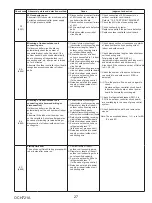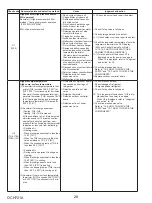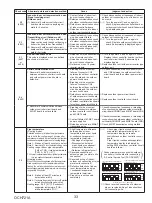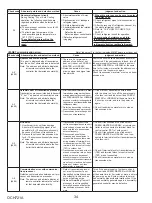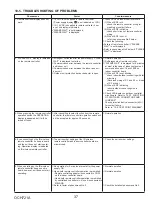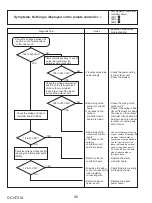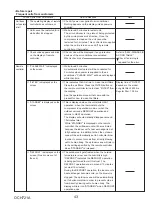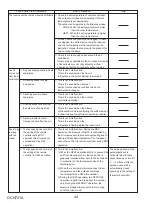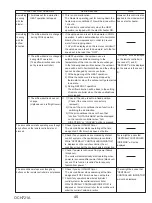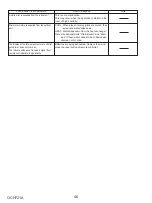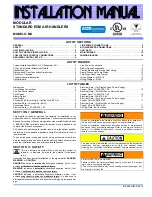
32
OCH721A
Check code Abnormal points and detection method
Cause
judgment and action
E0
or
E4
(6831,
6834)
Remote controller transmission error
(E0)/signal receiving error (E4)
1
Abnormal if main or sub remote controller
cannot receive normally any transmission
from indoor unit of refrigerant address “0”
for 3 minutes.
(Check code : E0)
2
Abnormal if sub-remote controller could
not receive for any signal for 2 minutes.
(Check code: E0)
1
Abnormal if indoor controller board
cannot receive any data normally from
remote controller board or from other
indoor controller board for 3 minutes.
(Check code: E4)
2
Indoor controller board cannot receive
any signal from remote controller for 2
minutes. (Check code: E4)
1
Contact failure at transmission
wire of remote controller
2
All remote controllers are set
as “sub” remote controller. In
this case, E0 is displayed on
remote controller, and E4 is
displayed at LED (LED1, LED2)
on the outdoor controller circuit
board.
3
Miswiring of remote controller
4
Defective transmitting receiving
circuit of remote controller
5
Defective transmitting receiving
circuit of indoor controller board
of refrigerant address “0”.
6
Noise has entered into the
transmission wire of remote
controller.
1
Check disconnection or looseness of indoor
unit or transmission wire of remote controller.
2
Set one of the remote controllers “main”.
If there is no problem with the action above.
3
Check wiring of remote controller.
• Total wiring length: max. 500 m [1640ft]
(Do not use cable with 3 or more cores.)
• The number of connecting indoor units:
max. 16 units
• The number of connecting remote control-
ler: max. 2 units
If the cause of trouble is not in above
1
–
3
,
4
Diagnose remote controllers.
a) When “RC OK” is displayed, remote con-
trollers have no problem.
Turn the power off, and on again to check.
If abnormality occurs again, replace indoor
controller board.
b) When “RC NG” is displayed, replace
remote controller.
c) When “RC E3” or "ERC 00-66" is dis-
played, noise may be causing abnormality.
Note: If the unit is not normal after replacing indoor
controller board in group control, indoor con-
troller board of address “0” may be abnormal.
E1
or
E2
(6832,
6833)
Remote controller control board
1
Abnormal if data cannot be normally
read from the nonvolatile memory of the
remote controller control board.
(Check code: E1)
2
Abnormal if the clock function of remote
controller cannot be normally operated.
(Check code: E2)
1
Defective remote controller
1
Replace remote controller.
E3
or
E5
(6201,
6203)
Remote controller transmission error (E3)/
signal receiving error (E5)
1
Abnormal if remote controller could not
find blank of transmission path for 6
seconds and could not transmit.
(Check code: E3)
2
Remote controller receives transmitted
data at the same time, compares the
data, and when detecting it, judges
different data to be abnormal 30
continuous times. (Check code: E3)
1
Abnormal if indoor controller board could
not find blank of transmission path.
(Check code: E5)
2
Indoor controller board receives
transmitted data at the same time,
compares the data, and when detecting
it, judges different data to be abnormal
30 continuous times. (Check code: E5)
1
2 remote controller are set as
“main.”
(In the case of 2 remote controllers)
2
Remote controller is connected
with 2 indoor units or more.
3
Repetition of refrigerant
address
4
Defective transmitting receiving
circuit of remote controller
5
Defective transmitting receiving
circuit of indoor controller board
6
Noise has entered into
transmission wire of remote
controller.
1
Set a remote controller to main, and the other
to sub.
2
Remote controller is connected with only one
indoor unit.
3
The address changes to a separate setting.
4
–
6
Diagnose remote controller.
a) When “RC OK” is displayed, remote controllers
have no problem.
Turn the power off, and on again to check.
When becoming abnormal again, replace
indoor controller board.
b) When “RC NG”is displayed, replace
remote controller.
c) When “RC E3”or “ERC 00-66”is displayed,
noise may be causing abnormality.
E6
(6840)
Indoor/outdoor unit communication error
(Signal receiving error)
1
Abnormal if indoor controller board could
not receive any signal normally for 6 min-
utes after turning the power on.
2
Abnormal if indoor controller board could
not receive any signal normally for 3 min-
utes.
3
Consider the unit as abnormal under
the following condition; When 2 or more
indoor units are connected to an out-
door unit, indoor controller board could
not receive a signal for 3 minutes from
outdoor controller circuit board, a signal
which allows outdoor controller circuit
board to transmit signals.
1
Contact failure, short circuit or
miswiring (reversed wiring) of
indoor/outdoor unit connecting
wire
2
Defective transmitting receiving
circuit of outdoor controller cir-
cuit board
3
Defective transmitting receiving
circuit of indoor controller board
4
Noise has entered into indoor/
outdoor unit connecting wire.
5
Defective fan motor
6
Defective rush current resistor
Note: Check LED display on outdoor controller
circuit board. (Connect A-Control service
tool (PAC-SK52ST))
Refer to EA–EC item if LED displays EA–AC.
1
Check disconnecting or looseness of indoor/outdoor unit
connecting wire of indoor unit or outdoor unit.
Check all the units in the case of twin indoor unit system.
2
–
4
Turn the power off, and on again to check.
If abnormality occurs again, replace
indoor controller board or outdoor controller
circuit board.
5
Turn the power off, and detach fan motor from con-
nector (CNF1). Then turn the power on again.
If abnormality is not displayed, replace fan motor.
If abnormality is displayed, replace outdoor
controller circuit board.
6
Check PTC1 and PTC2 on outdoor power
circuit board with tester. If open is detected,
replace the board.
Note: Other indoor controller board may have
defect in the case of twin indoor unit system.










